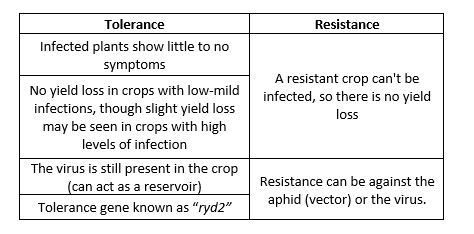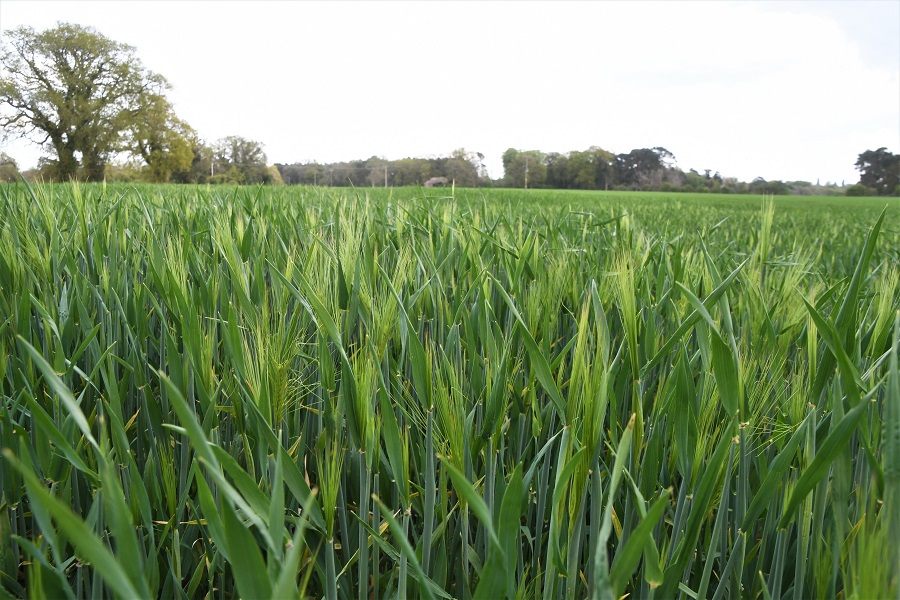With growers turning to cultural methods to control the impact of aphids on barley crops, KWS’ latest BYDV-tolerant variety looks set to play an important role. CPM finds out more.
Genetics are going to help when chemistry may not be able to.
By Charlotte Cunningham
Since the demise of neonicotinoid seed treatments, controlling plant viruses spread via aphids has been somewhat of a challenge for growers.
And when it comes to barley yellow dwarf virus (BYDV), the key culprits are the grain aphid and the bird cherry oat aphid, which – if left uncontrolled – can cause devastating yield losses in arable crops.
The issue is control options are now limited. And with the majority of growers now turning to pyrethroids, this undoubtedly puts more pressure on precious remaining chemistry.
So what’s the solution?
“Strategies are primarily based around the cultural control of aphid vectors, which includes trying to reduce sources of infection, such as green bridges and volunteers,” explains Kirsty Richards, cereals product manager. “Aphids can and should be monitored using facilities like AHDB’s BYDV Management Tool, but the important thing to remember with BYDV is that once symptoms appear, it’s too late for control measures.
“2019 was the first season where barley was drilled without seed treatments to control BYDV, but for many the severe wet weather prevented barley drillings all together, masking the overall impact of the loss of seed treatments.
“But in 2020, drilling was a different story for many. While fields were drilled, the weather stretched timings for aphicide applications in the autumn. Hence why this year many growers are reporting BYDV in their barley crops.”
With this in mind, and through its Sowing for Peak Performance initiative, KWS are now focused on bringing to market a BYDV-tolerant trait via its new variety – KWS Feeris, she explains. “The SSP initiative is all about the bigger picture – it encourages dissecting a variety and using key traits and performance indicators as little nuggets of information to guide decision making on a wider scale.
“So far we’ve largely been focusing on wheat, but we believe the introduction of this trait – and the variety – in a post-seed treatment world marks a step change for barley growers, allowing them to make more informed, holistic decisions when it comes to variety choice and early drilling.”
Amistar was KWS’ first-to-market BYDV-tolerant variety, but it was sold outside of the Recommended List, backed by a series of pilot trials to see how the technology could work across the UK and what potential it had to offer growers. “However, KWS Feeris – which is currently in the candidate stage – will be our first-to-market six-row BYDV tolerant variety to go through the RL process, meaning growers can be confident in its official ‘tried and tested’ status,” adds Kirsty.
According to winter barley breeder, Gabriella Everett, this is something KWS have been working on for quite some time. “When the chemistry ban came in, bringing the BYDV trait into a commercial variety was already well in the pipeline.”
The gene itself – ryd2 – has actually been around for over 50 years, she adds. “It has really good tolerance to BYDV and has so far showed no signs of breaking down – meaning growers can be confident in its capabilities.
Coined neatly as ‘the ultimate risk management tool for barley growers’ KWS Feeris is the firm’s latest conventional six-row candidate variety which boasts this tolerance to BYDV.
And aside from its BYDV tolerance, spawning from Amistar x KWS Kosmos, KWS Feeris is a good variety in its own right, explains Will Compson, UK country manager. “What really excites us about KWS Feeris is that it’s going to be the first BYDV? variety added to the RL that’s complete – and what I mean by that is that it ticks a lot of boxes.
“It has inherited its tolerance from Amistar, but its parentage also means it has excellent yield potential. UK data so far shows yields of 104%, but it really stands out in the West where it achieves its best yields of 109%. Not only does this mean KWS Feeris competes with some of the other conventional varieties in the market, but also the hybrids.
“And whereas before with some of these BYDV varieties we’ve seen a compromise with outright yield, you don’t get this with KWS Feeris.”
The BYDV tolerance is coupled with BaYMV resistance, and in terms of other diseases, it boasts a good all-round disease package including 7 for rhynchosporium and 8 for net blotch, adds Will.
“What’s more, KWS Feeris is reasonably tall-strawed (at 94cm) but a good 5-10cm shorter than commercial hybrid six-rows. It’s stiff strawed too which will be of benefit to many growers, especially those in prevalent blackgrass situations. KWS Feeris has similar maturity to KWS Orwell and at harvest will deliver good quality grain with a specific weight of 68.7kg/hl.”
Another plus point is that the variety is currently under evaluation by the MBC to determine malting potential for use in brewing, with all the signs currently looking positive, he adds.
Will believes that having this inherent tolerance will no doubt give growers more flexibility. “If we think about something like Deter, it gave protection for around six weeks – but this has got protection built in, so growers will benefit from that shield across the whole of the season.
“In short KWS Feeris is a good variety in its own right – but coupled with the added benefit of BYDV tolerance, it delivers an excellent risk management tool for barley growers in high pressure hotspots and those looking to push drilling as early as possible.
“If we look at some of the key feed areas, like the south coast, the West Country and across the coastal regions where a lot of barley is grown and where the pressure of BYDV is higher, this is where we believe KWS Feeris will come into its own.”
So while the claim for tolerance is there, the question is – does this stack up in the field?
KWS has been monitoring the BYDV tolerance in its own trials, explains Kirsty.
“A replicated trial was drilled in the autumn of 2020 to compare the performance of a susceptible two-row, KWS Orwell, a six-row conventional susceptible variety, Funky, and two tolerant lines – Amistar and KWS Feeris.
“The trial was drilled on 13 Sept 2020 at 250 seeds/m2 for the two-row and 250 seeds/m2 for conventional six-row lines.
The trial was then divided so that some plots relied on natural infection and others were inoculated with BYDV-infected aphids to achieve 20% and 50% infection to represent the pressure felt in some parts of the country this season, and the data from this will be reported later this year, she says.
“In the part of the trial that relied upon natural infection one block of the trial received no pyrethroid treatment. Another part did but the first pyrethroid spray was delayed and wasn’t applied until the 13 Oct 2020 because of the wet weather. This delay resulted in very poor control and the differences between susceptible and tolerant varieties is clear as the pictures show.
“Although the consequences of delaying the first pyrethroid may not have been as severe as at Fowlmere, poor control is evident in some commercial crops this year.”
View from the field
Norfolk grower, David Hill, has 8ha of KWS Feeris in the ground this year on a seed contract, and says so far things are looking well.
“It went into bone dry conditions in Sept, but we haven’t had any problems with the variety at all and think we’re on track for a good harvest.
“We grew Amistar a few years ago and Feeris is an obvious advance on that which is really beneficial – particularly from the BYDV point of view.”
David’s agronomist, Philip Simons – PrimeAg – said the fall out of autumn 2020 brought home just how missed products like Deter are and how important alternative solutions are going forward. “The problem was that when growers were able to get crops in early, unfortunately the weather came in and really delayed spraying.
“It just highlighted how much of a struggle it can be in the autumn if you do want to get crops in the ground early and then can’t get on with pyrethroids. In bad spots, infection can be devastating, with at least 30-40% yield losses seen.”
As such, Philip says the introduction of a commercially viable BYDV tolerant variety is going to be really important for growers going forward. “When we look at something like Feeris, regardless of the other traits it boasts, the BYDV tolerance just gives growers back that little bit of flexibility that they’ve been lacking since we lost neonicotinoid seed treatments.
“From an IPM point of view, this means we can be less reliant on pyrethroids too – which will ultimately help to protect their longevity – and in all crops, I think there will be a bigger emphasis on genetics over the coming years. Genetics are going to help when chemistry may not be able to.”
Tolerance vs resistance
In light of the trait launch, it’s important to stress the difference between tolerance and genetic resistance – though both are risk-reduction tools for growers in high-risk areas, explains Gabriella.
So what are the key differences?

“While there is no genetic resistance on the market, the tolerance conferred to KWS Feeris by the ryd2 gene means growers can be confident in season-long protection, even in high pressure scenarios.”
KWS Feeris – the stats

Breaking news!
Over the coming days, KWS is set to announce an exciting new initiative to capture more value from the BYDV trait – head online to find out more… www.kws.com
Fit for the Future
In this series of articles, CPM has teamed up for the fourth year with KWS to explore how crop markets may evolve, and profile growers set to deliver ongoing profitability.
The aim is to focus on the unique factors affecting variety performance, to optimise this and maximise return on investment. It highlights the value plant genetics can now play in variety selection as many factors are heavily influenced and even fixed by variety choice.
KWS is a leading breeder of cereals, oilseeds, sugar beet and maize. As a family-owned business, it is truly independent and entirely focussed on promoting success through the continual improvement of varieties with higher yields, strong disease and pest resistance, and excellent grain quality. We’re committed to your future just as much as you are.




